9. Candy Mountain (Rudy Wurlitzer and Robert Frank, 1988). Actor.
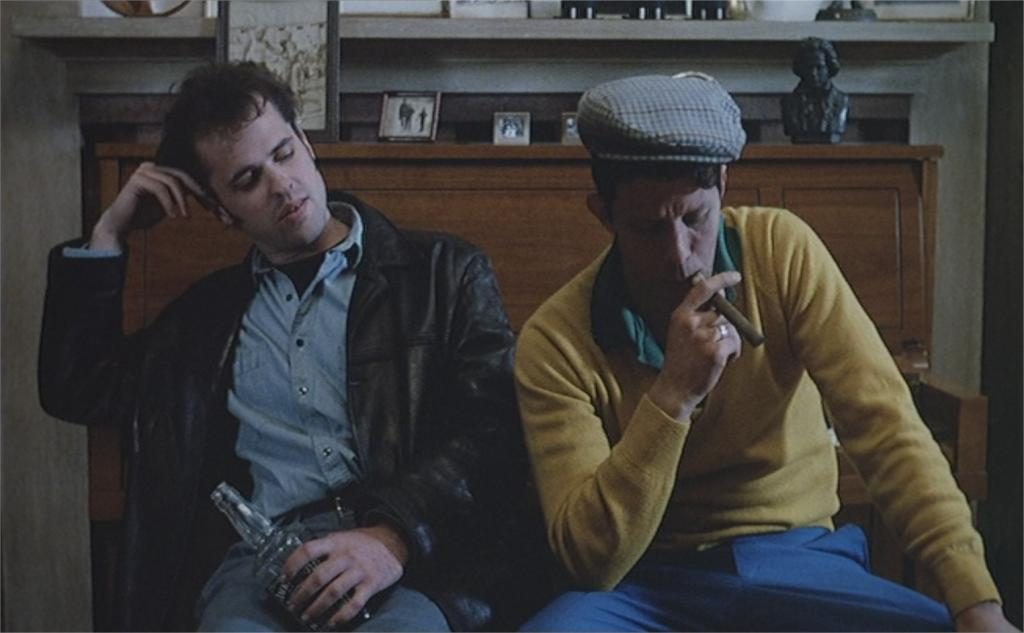
This curio was directed by the descendant of the inventor of jukebox, and features the likes of Leon Redbone, Dr. John, Joe Strummer, Arto Linsday, and Jim Jarmusch, along with Tom in a fun role. That alone is enough to draw interest.
Wurlitzer, a screenwriter and cult novelist, co-directed this minimalist cult classic with Robert Frank, making it his sole directing credit (his screenwriting resume is more impressive and includes the cult masterpieces Monte Hellman’s Two-Lane Blacktop, Sam Peckinpah’s Pat Garrett and Billy the Kid, Alex Cox’s Walker, Carrol Lombard’s Wind, and Bertolucci’s Last Buddha).
The performances in this road film are uneven, but Tom effectively nails his part of a sybarite and egotistical mogul, clad in robe and sipping the rye while talking far more about himself and golf than providing the protagonist with information he needs in the elusive search for the semi-legendary Elmore Silk. It’s hard to find, but well worth the search.
10. Big Time (Chris Blum, 1988). Self (and Frank O’Brien).
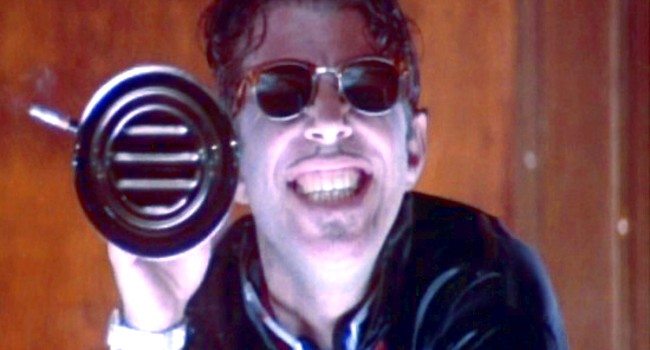
This hard to get concert film rivals “Stop Making Sense” as the best concert documentary of the 80’s (and, maybe, of all-time). But The Talking Heads film benefitted from having Jonathan Demme as director, whereas this film remains Chris Blum’s largest cinematic effort (he did shoot some music video for Tom, and also was a scenic designer for the Steppenwolf Theatre’s production of “Franks Wild Years”).
It’s obvious that Waits and Kathleen Brennan are the driving forces behind it. Having left Asylum to join the Island record label, Tom has reemerged as an almost a completely different artist.
While beginning as a singer/songwriter, and achieving a degree of fame as a unique voice performing blues, jazz, and lounge numbers, now the world saw a definitely one-of-a-kind performer who’s not afraid to go way out there at times, and who constantly challenges both himself and his audiences.
This concert film includes songs from the new Waits albums-“Swordfishtrombones”, “Rain Dogs”, and “Franks Wild Years”-the last one, “un Operachi Romantico in Two Acts”, as well as footage from the theatrical production of “Franks Wild Years” and several vignettes connecting the songs (performed at different times), showcasing Tom as a raconteur and banterer extraordinaire.
While the audio album “Big Time” was also released, this film is a unique chance to see Tom live, and, as a DVD release is nowhere in sight, perhaps the best remaining reason to own a VHS player.
11. Cold Feet (Robert Dornhelm, 1989). Actor.
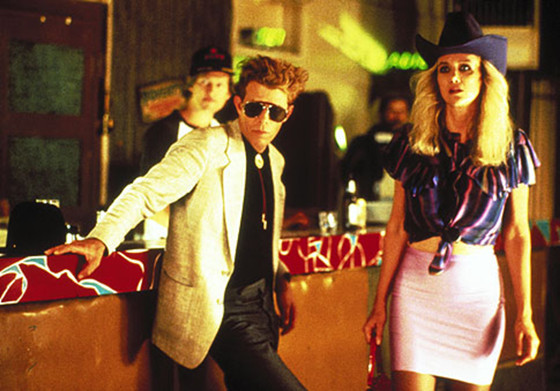
A rarity from Tom-a main role. Reviews at the time weren’t kind to this dark heist comedy, which also stars Keith Carradine and Sally Kirkland, and features Rip Torn and a young Bill Pullman in support.
In Tom’s own words, “It’s about the possibilities of spandex. Coming soon to a slaughterhouse near you”. Does have moments, most supplied by Tom as a psychotic yet sensitive hitman (try not to laugh as he does sit-ups in a window of a moving car, yelling at other cars as they drive by). Poor Sally Kirkland fares the worst as an alluring nymphomaniac with a shoe fetish, particularly with flowery lines she has to deliver.
Interestingly, the film had not just one but two writers, both from Michigan, and both primarily known for their prose about nature. Thomas McGuane penned Missouri Breaks and Panama, while Jim Harrison-Legends of the Fall. They are able to craft up good atmosphere, but dialogue is not the strongest suite of either, and the pedestrian direction of TV Hack Robert Dornhelm does not help. Worth to be seen once or twice for good actors and Tom’s zany antics. Tequila recommended as an enhancement.
12. The Fisher King (Terry Gilliam, 1991). Actor (uncredited).
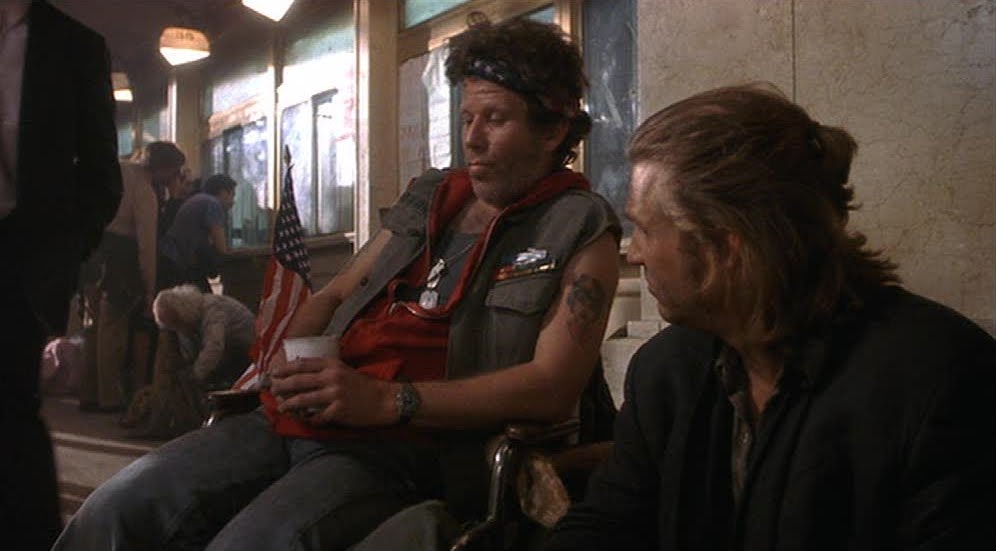
It could be said that the entire oeuvre of Terry Gilliam consists of presenting various stages of madness on the silver screen, with industry backing. Dreams, nightmares, delusions, hallucinatory visions-all there.
The Fisher King is one his best films, in no small part due to the excellent cast. The Jeff Bridges/Robin Williams duo is fantastically dynamic as a washed-out DJ and a homeless man who helps him regain his conscience and sense of purpose in the world. The female leads are equally great, with Amanda Plummer and Mercedes Ruehl turning in, perhaps, their best performances.
Although Tom is uncredited, he fits in perfectly with these talented performances, and easily steals the show for his few minutes. Here he plays a disabled veteran, begging for change at Grand Central Station. In a memorable mini-monologue, he enlightens Bridges’s character on the moral dynamic that exists between those begging for alms and those giving them.
Credit to Gilliam’s eye and ear-Tom delivers those lines like no one else can, in his inimitable manner. Have to be seen-“You see, I’m whatcha call a moral traffic light, really.” Overall, this is one of Gilliam’s best films, with a humane and poignant story, excellent elements (NYC is another uncredited actor in it-one really gets the feel of the Big Apple), and great acting turns. Tom is in good company here.
13. Fishing with John (John Lurie, 1991). Self.
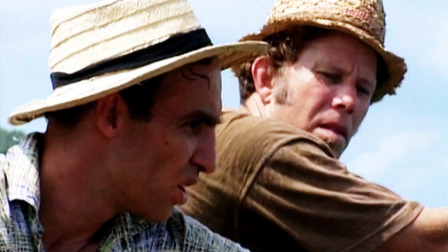
Thirty minutes of droll hilarity. Tom’s Down by Law co-star John Lurie came up with the idea for this very short but memorable TV series, where he would go fishing with his fascinating friends, and end up bantering the day away.
Six episodes were made-casting for sharks with Jim Jarmusch, a hilariously “supernatural” Costa-Rica outing with Matt Dillon, ice-fishing in Maine with Willem Dafoe, and a two-part episode of venturing off the coast of Thailand with Dennis Hopper so to catch the elusive giant squid (or maybe to avoid being caught by it).
Tom’s episode is the second one, and it features John and Tom venturing to Jamaica to fish for red snapper. The exchange between the boys rather resembles the bickering of their characters in Down by Law-at one point, while John paddles the canoe, Tom breaks out into an improv song, forcing John to exclaim “Row, Tom!”. Adding to the humor is the announcer, who narrates the action in earnest, like an actual wildlife show.
Often, his gravitas has nothing in common with what’s actually happening on screen, at other times-it adds significance to the minute events, to a chuckle-inducing effect (“The long walk home makes Tom a little grouchy”, “A game of cards on dry land makes Tom feel much better”). The entire show was released on a Criterion Collection DVD, and it’s a must for fans of music, cinema, and absurdity.
14. Night on Earth (Jim Jarmusch, 1991). Composer.
Tom returns to work with his friend Jim Jarmusch, providing the score to this low-key, minimalistic gem. The film consists of 5 episodes, taking place almost entirely in the taxicabs and focusing on the interactions of drivers and passengers. The episodes are set, respectively, in L.A., New York, Paris, Rome, and Helsinki. Each episode is unique in how it captures the spirit of a given city-the sunset of L.A., the pace of NYC, the lights of Paris, the warm darkness of Rome, and the cold glow of Helsinki.
The L.A. episode, starring Gena Rowlands and Winona Ryder, lags at times, but the rest are pure gold-Giancarlo Esposito’s and Rosie Perez’s loud Brooklynites descending upon Armin Mueller-Stahl’s German clown-turned-cabbie, the razor-sharp Beatrice Dalle’s blind passenger effectively teaching Isaach de Bankole’s Ivorian driver a thing or two, Roberto Benigni’s fast-talking Roman cabbie shocking his monsignor passenger, and Matti Pellonpaa’s taciturn Finn cabbie relaying the saddest story in the world to his drunken passengers.
For the film, Waits wrote two songs-“Back in the Good Old World” (two versions of which, one a gypsy-vaudeville, other-waltz, bookend the film), and “On the Other Side of the World”, as well as several “themes” and “moods” for each city.
Using a varied instrumentation, that includes bass clarinet, baritone horn, pan pipes, Stinson band organ, and harmonium, in addition to more traditional instruments, Waits created a haunting and very effective musical accompaniment to Jarmusch’s unique vision.
15. Until the End of the World (Wim Wenders, 1991). Cameo.
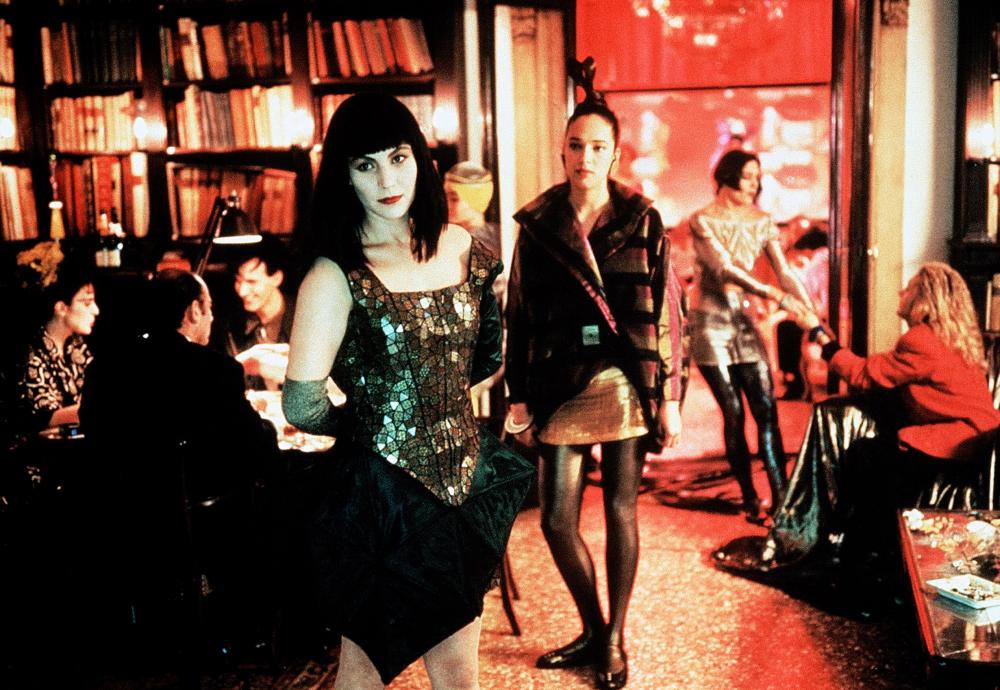
Spanning 15 cities, 7 countries, and 4 continents, it took financing from several countries to bring Wim Wenders’s ambitious project to life. The returns were low, due to hazy story, but as a visual and aural experience it more than stands the test of time.
A romantic melodrama set against a potential impending apocalypse, it features William Hurt globetrotting to escape pursuit by nefarious government forces and his former partners in crime, also followed by Solveig Dommartin’s Claire, who may have a thing for him. The complicated plot and all it strands deserve at least an of its own to describe. But the astounding elements are all here. Robby Muller’s cinematography is at its usual artistic best. Music deservers a special mention.
As the film is set in 1999, Wenders has asked the contributing artists to provide a song of the kind that they feel like they’ll be performing in 1999, nearly a decade after the film’s making.
That resulted in an amazing soundtrack, featuring all-new entries by Talking Heads, Crime & The City Solution, Lou Reed, R.E.M., Elvis Costello, Nick Cave and The Bad Seeds, U2, Depeche Mode, Patti Smith, and many others. That makes Tom’s absence from it all the more disappointing. He does make a brief cameo appearance as a singer in a Berlin bar, but it leaves one wishing all the more for the original Waits number.
It would also mark Tom’s only collaboration with Wim Wenders, and that’ also unfortunate, as Wenders has both successfully used musicians in features (notably, Nick Cave, Lou Reed, and John Lurie), and made some of the best musical documentaries of all time (Buena Vista Social Club, Pina). Hopefully, Tom and Wim will find each other again before the world’s end.
16. Bram Stoker’s Dracula (Francis Ford Coppola, 1992). Actor.

Arguably, Coppola’s best film since Apocalypse Now, this is a deft and creative adaptation of the great vampire novel. Here Coppola managed to please everyone, combining the best of several genres. It’s at once a Gothic tragedy, a love story, a horror masterpiece, and a dark comedy.
Something for everyone here. The bravura visuals are by far the best thing about this film-creative camera work, fantastic sets, otherworldly makeup, unique costumes (by the late, great Eiko Ishioka, who was rewarded with an Oscar)-all elements are top-notch here.
Even though he utilized the same technique as in the failed One Form the Heart, here (backed by artificiality of the original story) it pays dividends. Coppola also made mostly inspired and unique casting choices (with one notable exception-Keanu Reeves appears a limp noodle as Jonathan Harker).
Winona Ryder does really well as a female lead. But much of the humor and drive come from the two male leads/antagonists-Gary Oldman as Dracula and Anthony Hopkins as Van Helsing. Both of them liven up the usual Goth dreariness with sharp words and a twinkle in the eye (especially Hopkins). They are aided by Tom Waits and his character. In a small but very memorable role, Waits plays R.M. Renfield, an inmate in the lunatic asylum.
A one-time partner of Van Helsing, Renfield has lost his marbles after a visit to Dracula’s castle. Initially, Steve Buscemi was due to play the part, but it ended up going to Tom. He doesn’t disappoint-his Renfield is a true loony, at once inspiring fear, laughter, and pity.
Sporting steampunk goggles and a Bride-of-Frankenstein hairdo, spending his time mostly either chomping on insects, spewing cryptic threats, or bellowing at the top of the voice from his cell window-Renfield is definitely Tom’s most memorable role yet, and a worthy addition to a good film.
Tom gem: “Walk Away”. Appears in-“Dead Man Walking”. An original composition, somewhat harking back to his great “Walking Spanish” song. Works well in Tim Robbins’s death row drama.
17. Short Cuts (Robert Altman, 1993). Actor.
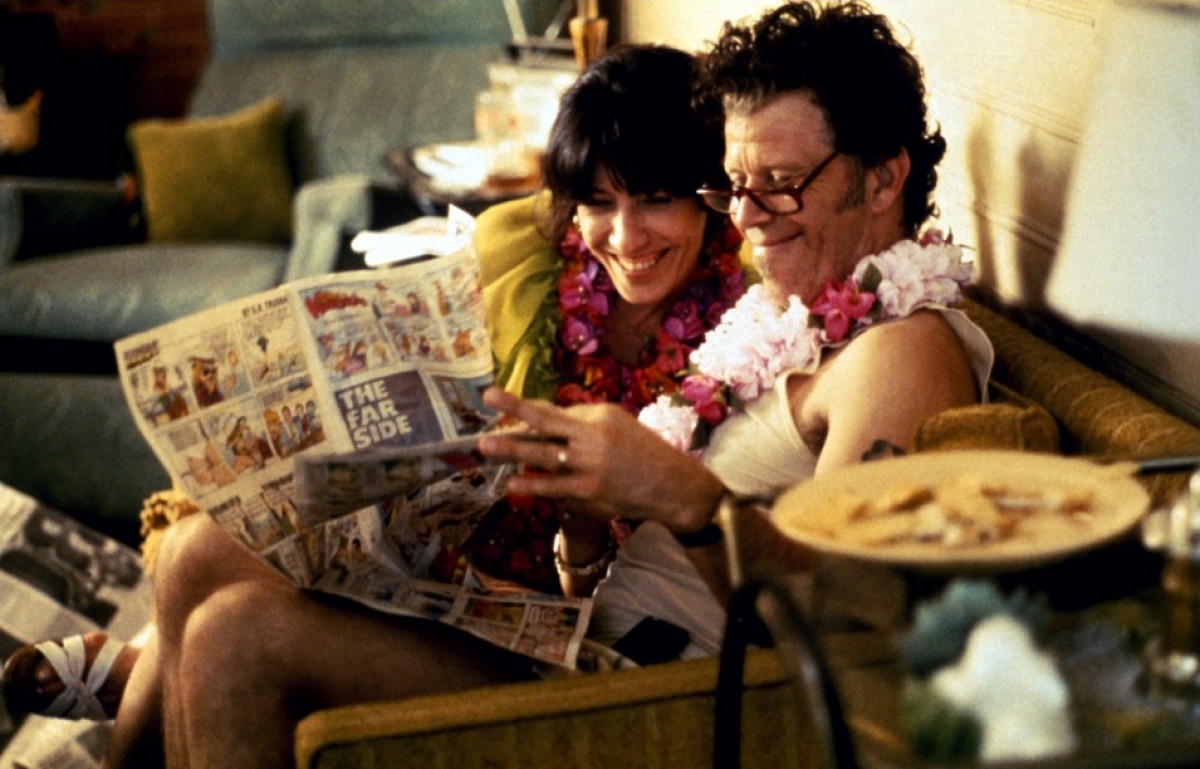
Under Altman’s direction, Tom had succeeded in a relatively new (for him) challenge-to convincingly portray a character, rather than to present a version of himself on screen. Altman’s masterpiece of ensemble acting and literary adaptation, it’s an engaging and atmospheric film that lingers in memory.
Taking nine short stories and a poem by the recently deceased master of laconic prose Raymond Carver, Altman achieves near perfection in just about every aspect. Although he ended up changing the setting from Oregon to California, and in some instances (including Tom’s character) also changed names and occupations of the characters, Altman has maintained the spirit (rather than the letter) of the literary original.
Carver has been called the Chekhov of American literature for his short stories that are both laconic in words and full of substance. In the stories used for the film, the Tolstoy quote comes to mind-“All happy families are alike; each unhappy family is unhappy in its own way.” Altman both illustrates this concept and somewhat argues it.
The humanity of the characters is both their strength and weakness, no matter the economic situation or social background. While each Carver story is a mini-world of its own, Altman interconnects them, making all players on the stage that is life. For him it was a welcome return to form-having achieved fame with large ensemble casts of MASH and Nashville, by the end of 80’s he really scaled down, mainly filming stage adaptations (Fool for Love, Secret Honor, Beyond Therapy).
1992’s The Player and this film convincingly prove that his talent for directing large and diverse cast hasn’t diminished. The cast of Short Cuts is truly eclectic, including some notably talented actors, some who are relatively obscure, and some musicians (besides Tom, present here are Lyle Lovett, Annie Ross, Lori Singer, and Huey Lewis).
The list of actors is astounding-Andie McDowell, Matthew Modine, Julianne Moore, Bruce Davison, Jennifer Jason Leigh, Robert Downey Jr., Madeleine Stowe, Lily Tomlin, Tim Robbins, Fred Ward, Chris Penn-and many of them turned in some of their best performances.
By Altman’s admission, the first unhappy family filmed were the Piggots, played by Tom and Lily Tomlin-he an alcoholic limo driver, and she-a waitress in a diner. According to Altman, both were near-perfect, causing him to worry that the rest of the cast may not reach the high standard that they established.
Fortunately, they did, making this one of the best ensemble triumphs in film history. For Robert Altman, it was an autumnal return to form, while for Tom-a new accomplishment and proof that he was an actor proper, rather than an acting singer.
Tom gem: “The Earth Died Screaming”. Appears in-“Twelve Monkeys”. A perfect addition to the typically maddening atmosphere of Terry Gilliam’s psychedelic classic. Off Tom’s great “Bone Machine” album, the clangy and percussive tune with Tom’s wailing on the refrain goes well with post-apocalyptic setting.